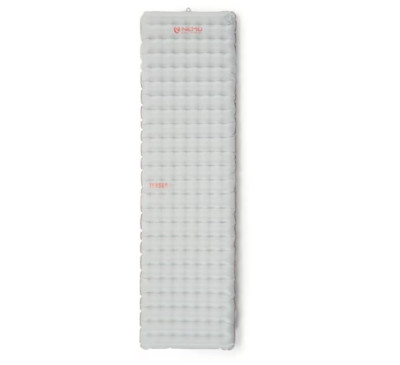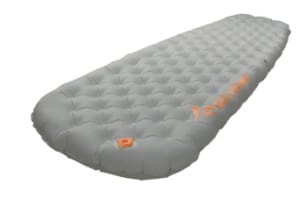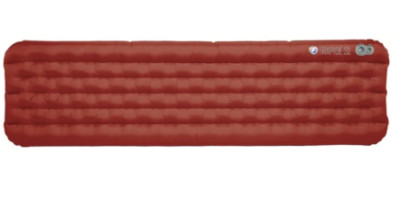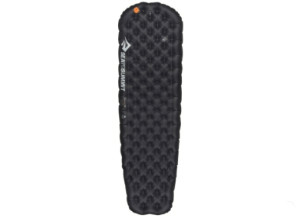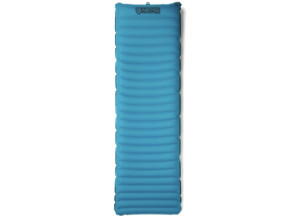An insulating sleeping pad is a must-have for backpackers who sleep on the ground in tents and under tarp shelters to prevent body heat loss to the ground. The best backpacking sleeping pads are air mattresses or foam pads because they’re lightweight and compact. While they vary in composition and thickness, they are all designed to complement your sleep insulation, keeping you warm, so your body can recover after a day of hiking.
When choosing a sleeping pad it is important to also consider its weight, R-value, durability, size, thickness, comfort, and price. What are your priorities?
Here are our picks for the best 10 sleeping pads available today based on these dimensions. Many of these sleeping pads are available in different lengths, widths, and weights, making it easy to find a good choice to fit your needs.
1. NEMO Tensor All-Season UL Insulated
2. Exped Ultra 5R

The Exped Ultra 5R Air Mattress is a lightweight inflatable sleeping pad that’s three inches thick and has an R-value of 4.8. It contains synthetic insulation, instead of reflective films, which makes it very quiet to sleep on, and is covered with a durable 20d polyester non-slip fabric. The pad has a pair of flat stemless valves for inflation and deflation and vertical baffles that are designed to keep you from rolling off the pad at night. The Ultra 5R is available in three mummy and three rectangular sizes including a regular width, a wide width, and a long and wide pad. All six sizes are priced identically so you can pick the size you want without having to sweat a higher price point. The Ultra 5R is also bundled with a large 45L inflation sack/dry bag called a Schnozzel (a $50 value, also available separately), which can be used as a waterproof pack liner. Read the SectionHiker review.
3. Sea-to-Summit Ether Light XT Insulated Pad
4. Therm-a-Rest NeoAir XLite NXT

5. Therm-a-Rest NeoAir XTherm NXT
6. Big Agnes Rapide SL Insulated
7. Sea-to-Summit Ether Light XT Extreme
8. NEMO Quasar 3D Insulated Air
9. Therm-a-Rest Z Lite Sol Foam Pad
10. NEMO Switchback Foam Pad
Backpacking Sleeping Pad Guide
Choosing a sleeping pad requires prioritizing between multiple factors, some of which can be at odds with one another.
Sleeping Pad R-Values and Air Temperature in Degrees
What’s the correlation between air temperature and sleeping pad R-values? When do you need a pad with a higher R-value? This table is based on Exped’s recommendations in Fahrenheit and Celsius degrees.
| Air Temperature (F): | 50 | 30 | 25 | 10 | 0 | -15 | -25 | -40 |
| Minimum R-Value | 1 | 2 | 3 | 4 | 5 | 6 | 7 | 8 |
| Air Temperature (C): | 10 | -1 | -4 | -12 | -18 | -26 | -32 | -40 |
| Minimum R-Value | 1 | 2 | 3 | 4 | 5 | 6 | 7 | 8 |
In addition:
- R-values are additive, so you can combine two pads to increase your warmth level.
- Women need higher R-values pads because they have lower body mass than men. An additional R-value of 1 is usually a good hedge for women and other cold sleepers
Sleeping Pad Thickness
Thicker sleeping pads are often more comfortable for side sleepers because they provide more cushioning under the hip bones. Depending on their length and width, it may take more breaths to inflate a very thick air pad, something to factor into your decision.
Sleeping Pad Dimensions
Most popular sleeping pads are available in a wide range of lengths and widths. While large pads are often more comfortable, they’re often heavier. Most pads are available in a standard 72″ x 20″ size. But many pads are also available in longer, shorter, and wider sizes, or mummy and rectangular shapes.
Sleeping Pad Weight
A sleeping pad is one of the most important items on your gear list in terms of comfort and sleep insulation. While the weight of all backpacking gear matters, don’t make the mistake of being miserable at night by choosing a pad that compromises the quality of your sleep, simply to reduce the weight of your gear list. For example, most sleeping bag and quilt temperature ratings assume that you’re sleeping on a pad with an R-value between 4.0 and 5.0. If you sleep with a pad that has a lower R-value, even in summer, you probably won’t be able to experience the full temperature rating of your sleep insulation. That’s a sobering thought.
Sleeping Pad Compactness
The size and compactness of a sleeping pad can be an important fact depending on your style of packing and the size of your backpack. Inflatable pads usually pack up the smallest, self-inflating pads are usually larger, and foam pads are the largest. Depending on how you pack, foam sleeping pads may need to be attached to the outside of your backpack because they’re so large. While closed-cell foam pads don’t absorb water if they get wet, you’ll want to dry one off before you put a sleeping bag or quilt on top of it, after a wet day on the trail.
Sleeping Pad Types
There are three types of sleeping pads: air mattresses, self-inflating mattresses, and closed-cell foam pads. Air mattresses provide the greatest comfort and pack up the smallest when deflated. Most come with a lightweight stuff sack that can be used to inflate them. Self-inflating mattresses are usually the heaviest and will up partially with air when unrolled for use. You still have to blow them up a bit, but only a minor amount. Closed-cell foam pads are the least expensive but they are bulky have to be attached to the exterior of your pack. They are very reliable however because they’re made with foam so they can’t be punctured and they’re waterproof, so they won’t get heavier if it rains.
Sleeping Pad R-Values
The most reliable measure of insulation is R-value. Beginning in 2020, a new Sleeping Bag R-Value Standard was adopted by the outdoor industry and most of the major sleeping pad manufacturers including Therm-a-Rest, NEMO, Sea-to-Summit, REI, Big Agnes, and Klymiy have retested and re-rated their sleeping pads using it. Klymit, notably, has not. This new standard benefits consumers because it makes it possible, for the first time, to compare sleeping pads by their R-values because they all use the same testing methodology.
For three-season backpacking and camping, an R-value of 2, or higher, is recommended. For winter backpacking and camping, an R-value of 5, or higher, is recommended. R-values are additive, so you can stack two pads to increase your warmth level. Women need higher R-values pads because they have lower body mass than men. An additional R-value of 1 is usually a good hedge for women and other cold sleepers
Sleeping Pad Durability
Foam sleeping pads are the most durable, self-inflating pads are the next most durable, and inflatable air mattresses the least. Inflatable air mattresses tend to fail in two places: the valves and at the seams of fabric. Flat valves that are flush with the surface of the sleeping pad are more durable than stick valves because they have no moving parts and can’t catch on obstructions.
Check Out All of SectionHiker’s Gear Guides!
SectionHiker is reader-supported. We only make money if you purchase a product through our affiliate links. Help us continue to test and write unsponsored and independent gear reviews, beginner FAQs, and free hiking guides.

